Meet 5 artists who capture the urban landscape
This story was featured in the September 2016 issue of Southwest Art magazine. Get the Southwest Art September 2016 print issue or digital download now–then subscribe to Southwest Art and never miss another story.
Greg Gandy
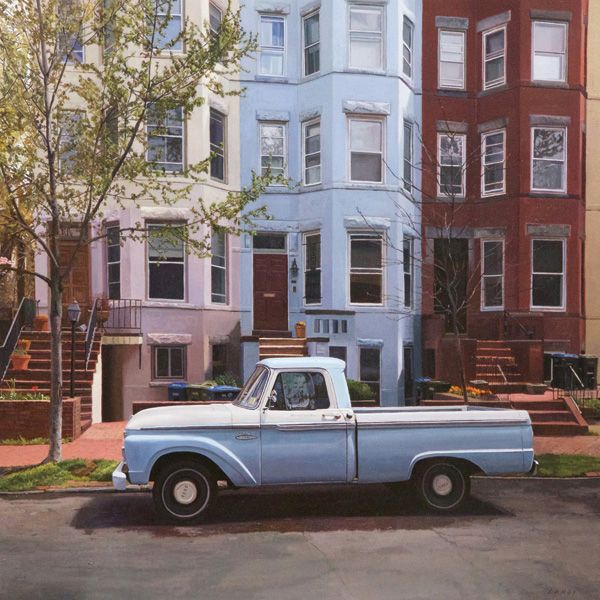
Greg Gandy, Blue Ford, oil, 30 x 30.
Having grown up in the tranquil town of Turlock, surrounded by California’s agriculture-intensive Central Valley, Greg Gandy may well have been acutely receptive to the visual allure of city life when he moved to San Francisco 12 years ago. That’s where, in 2007, he earned a master’s degree from the Academy of Art University, and where he now teaches cityscape and still-life painting part time to grad students. And he still feels compelled to capture the scenes he sees there.
“San Francisco has a special light and mood that’s hard to capture in words,” he says. “There may be something I walk by every day and not notice, and then there’ll be a particular time of day that creates a specific mood, a fleeting moment that feels like it needs to last forever.” He’ll record that impression with his camera and sketchbook, then work up a thumbnail composition that he’ll finally sketch onto canvas before completing one of his meticulously detailed oil paintings.
Gandy doesn’t limit his focus to the Bay Area, however. On a recent visit to Washington, DC, for example, he happened upon a vintage pickup truck parked in front of beautiful old brownstones. The resulting BLUE FORD possesses an air of nostalgic beauty heightened by the mundane background presence of trash and recycling bins. “Cityscapes,” he explains, “are a subject everybody can relate to.”
Gandy’s works are shown at Principle Gallery, Alexandria, VA, and Charleston, SC; John Pence Gallery, San Francisco, CA; Gallery 1261, Denver, CO; and www.greggandy.com. —Norman Kolpas
West Fraser
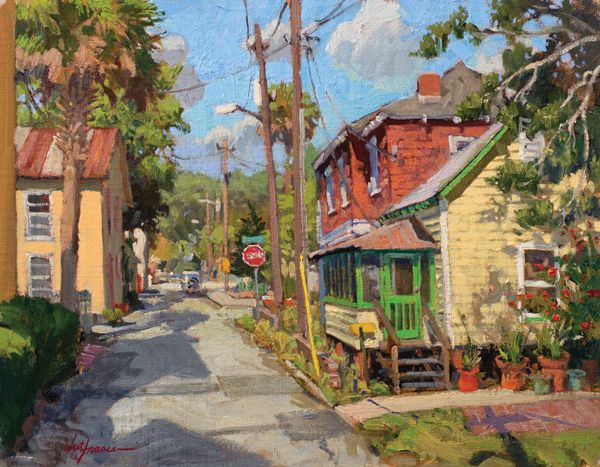
West Fraser, Lincolnville, oil, 14 x 18.
West Fraser likens his cityscapes of Charleston (his hometown) and other gracious old southern enclaves to pieces of music, “with rhythm and notes,” he explains. “I’m interested in composition—how light and shadow and structure work together to lead viewers in, hold them on a journey through the painting, and then, after they’ve explored, give them a place to go away and release them.”
After some four decades working as a full-time fine artist, he’s built up quite an oeuvre, which lovers of his impressionistic style can savor in his 2001 book Charleston in My Time, as well as in the newly published Painting the Southern Coast, with 260 images encompassing the Atlantic shore from North Carolina down to St. Augustine, FL.
Whatever the location, notes Fraser, “It all starts with my inherent desire to capture a sense of that place.” THE YELLOW DOOR, for example, evokes the bright, hot, tropical sunlight of springtime in a gentrified neighborhood of Savannah, GA; STRAWBERRY MOON SOLSTICE presents a moody Charleston nocturne he captured this year on the first night of summer. Whatever the scene, adds the artist, “I’m painting an environment rather than an object, as if the viewer is standing in my place and watching the world go by.”
See Fraser’s paintings at Helena Fox Fine Art, Charleston, SC; Claudia Heath Fine Art, Charlotte, NC; J. Russell Jinishian Gallery, Fairfield, CT; and www.westfraserstudio.com. —Norman Kolpas
Craig Nelson
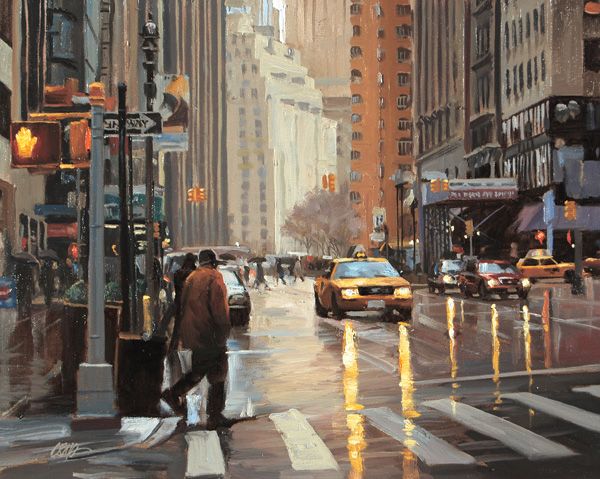
Craig Nelson, Out and About, oil, 24 x 30.
When Craig Nelson transitioned to full-time fine artist in the late 1980s from a career as an in-demand illustrator of album covers and movie posters—in the process moving from Los Angeles to Northern California wine country—most of his painterly oils were figurative. “But my biggest detriment as an artist,” he laughs, “is that I get bored easily. So I’m always looking for different subjects.”
His search for something new led him to landscapes and cityscapes. “But all my students are already painting San Francisco,” says Nelson, who directs degree programs in drawing and painting at that city’s widely respected Academy of Art University. So he’s journeyed farther afield to capture urban settings in places as diverse as New York City, London, and Tuscany. “I look for light, mood, and character,” he says. “I want subjects that look like they have a history.”
Rich in their sense of place, Nelson’s paintings feel deeply immersive, capturing such iconic imagery as London’s red telephone booths and double-decker busses and the rain-slicked streets of Manhattan. In his cityscapes, one notable element is human forms. “It’s not the city that makes the people,” says Nelson, still a figurative artist at heart. “It’s the people that make the city.”
Nelson’s work can be seen at Ella Walton Richardson Fine Art, Charleston, SC; The Garden Gallery, Half Moon Bay, CA; Sugarman-Peterson Gallery, Santa Fe, NM; The Legacy Gallery, Scottsdale, AZ; Waterhouse Gallery, Santa Barbara, CA; and www.craigzart.com. —Norman Kolpas
Teresa Saia
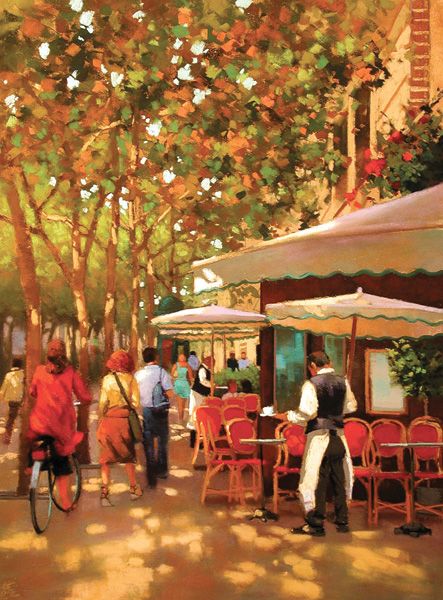
Teresa Saia, The Lunch Rush, pastel, 24 x 18.
At least once a year, Teresa Saia feels compelled to visit Paris, even if only for a few days en route home from the painting workshops she teaches in Italy and elsewhere. “It’s my favorite city,” she says. “I walk miles and miles there every day, and I love sitting in sidewalk cafés or a beautiful park, sketching. I’m captivated by the light there, the dappled patterns it forms cutting through and bouncing off the trees, and the fun play of movement and the gestures of the people as they interact.”
The result of her fascination can be enjoyed in her many luminous scenes featuring the fabled City of Light, which she executes in a style she describes as “contemporary impressionism.” She credits the deep, richly saturated color she achieves to her medium of choice, pastels. “I love the vibrancy of the colors, the hard or soft edge quality you can achieve, and the ability to layer the colors one upon the other.”
Saia reckons that around a third of her images feature manmade environments, the rest focusing largely on landscapes, although that may shift slightly now that she and her husband, Doug, have moved from the heart of Seattle to a tranquil water-view home on Whidbey Island, about 40 miles to the north. “I do miss the energy of the city,” she says. “But I can revisit it by painting a cityscape whenever I choose.”
Saia’s works are available at Howard/Mandville Gallery, Kirkland, WA; Studio Siena, Whidbey Island, WA; and www.teresasaia.com. —Norman Kolpas
Bruce Cody
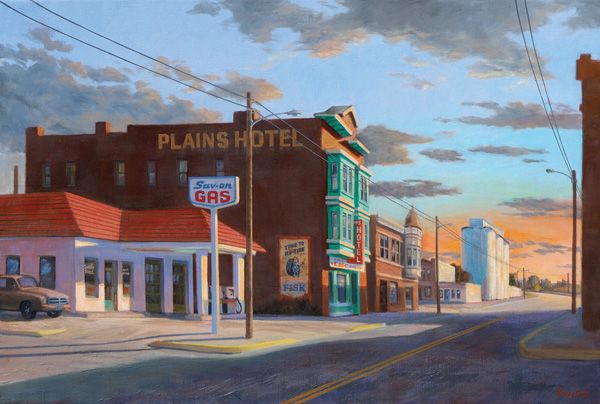
Bruce Cody, Plains Town Twilight, oil, 24 x 36.
“A cityscape is a big still life for me,” says painter Bruce Cody. That statement is no mere fanciful expression for the artist, who recently relocated from Santa Fe to the Phoenix area. Attracted by the geometric shapes of older structures, he explains that he feels “very involved in portraying the arrangement of buildings”—so much so, in fact, that his compositions often alter the reality of the towns he photographs or sketches for reference on his frequent road trips. His PLAINS TOWN TWILIGHT, for example, flips the relative positions of an old Denver hotel and gas station, and then adds a cupola-adorned edifice he saw on Route 66 in Oklahoma and some West Texas grain elevators. “It all helps create the mood of a lonely town out in the middle of nowhere,” he says.
Many of Cody’s evocative works also include hand-drawn or neon business signage, artifacts he knows firsthand from a childhood spent assisting in his father’s sign shop. After earning his master of fine arts at Washington State University, he spent 17 years teaching art at Colorado State University before dedicating himself to painting full time in 1983. “I came up when abstract expressionism was the mindset of art faculties,” he recalls. “Pop art gave me a release to paint images of advertising motifs, and then I had a phase of geometric patterns. By 1974, I got tired of that and started painting outdoors.”
See Cody’s work at Coda Gallery, Palm Desert, CA; Manitou Galleries, Santa Fe, NM; Leslie Levy Fine Art, Scottsdale, AZ; Acosta-Strong Fine Art, Oklahoma City, OK; and www.brucecody.com. — Norman Kolpas
Featured in the September 2016 issue of Southwest Art magazine. Get the Southwest Art September 2016 print issue or digital download now–then subscribe to Southwest Art and never miss another story.
MORE RESOURCES FOR ART COLLECTORS & ENTHUSIASTS
• Subscribe to Southwest Art magazine
• Learn how to paint & how to draw with downloads, books, videos & more from North Light Shop
• Sign up for your Southwest Art email newsletter & download a FREE ebook





